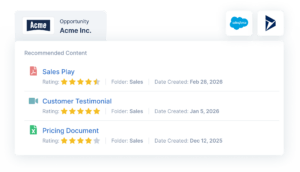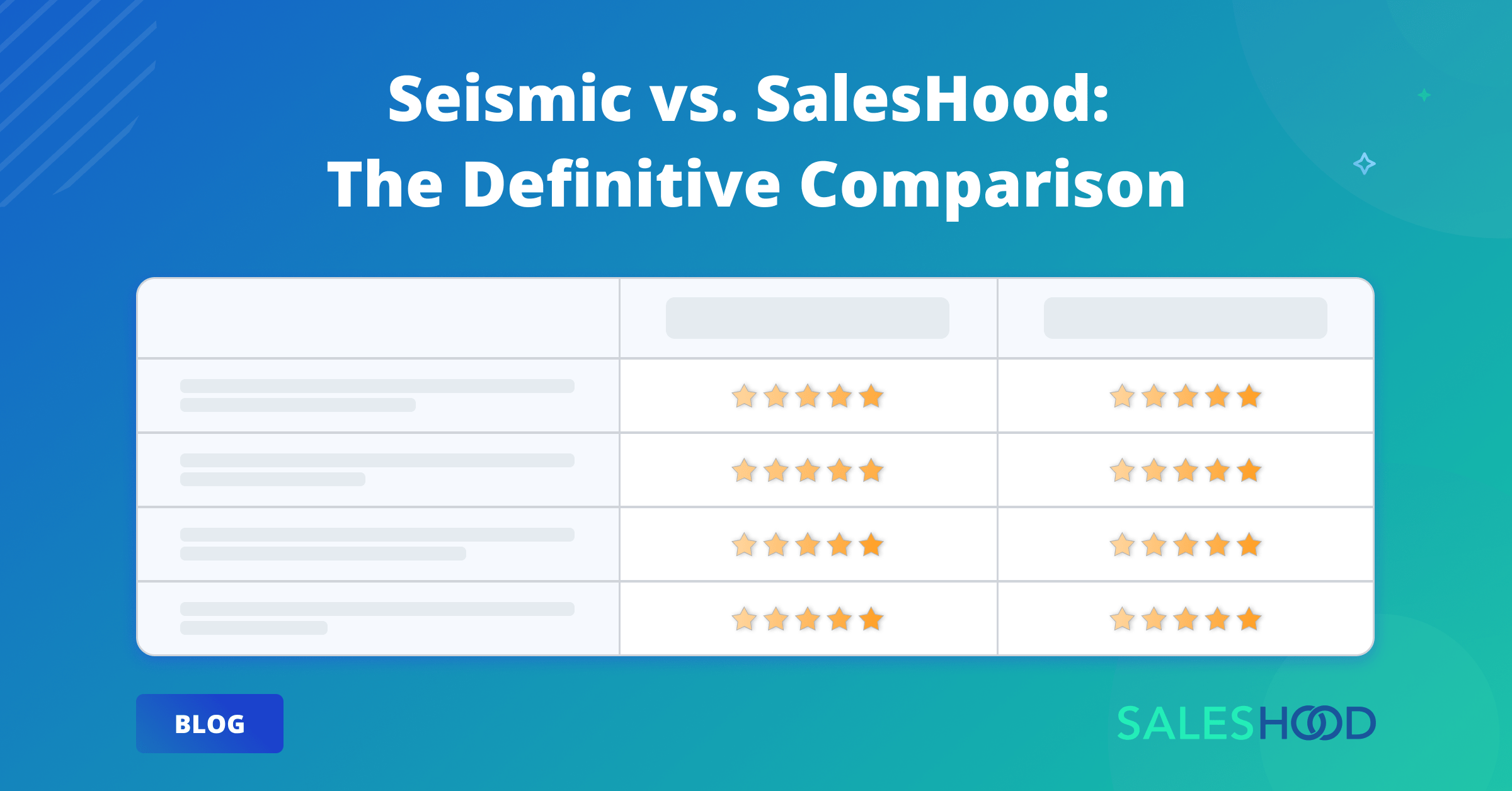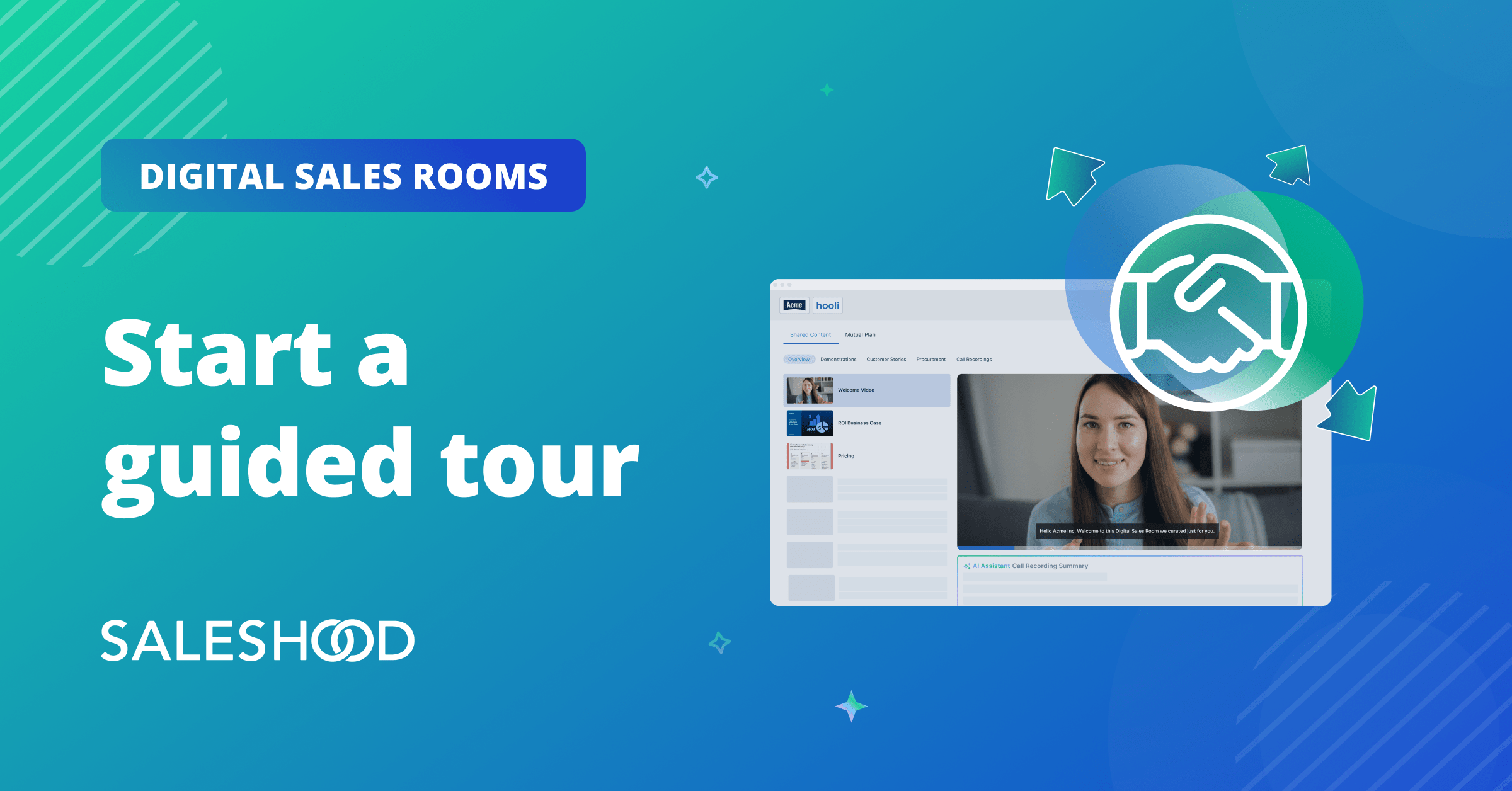Sales content and sales communications should be attention-grabbing, high-impact, and action-oriented. Whether you’re engaging with customers, coaching your sales team, or aligning cross-functional efforts, the right approach to communication makes all the difference. In this blog, we focus on what separates effective content across the entire customer journey and how AI is helping to improve sales content activation.
According to a recent Gartner survey, 82% of surveyed sales leaders believe enablement content and/or delivery must significantly change to meet revenue goals.
AI is revolutionizing sales content activation by automating recommendations, optimizing engagement, and ensuring content is surfaced at the right time. It’s about balancing motivation and instruction while being clear about expectations.
- AI is improving the efficiency of GTMs teams showing what content is driving revenue.
- AI is improving effectiveness with just-in-time enablement.
- AI is improving sales execution with Digital Sales Rooms.
Here are 8 tips practical and actionable tips you can apply to your sales content strategy today!
1. Answer: What’s in it for me? (WIFM)
Strong communication starts with establishing value. Answering “What’s in it for me?” (WIFM) ensures your audience immediately understands why your content matters and how it directly benefits them.
AI-powered content personalization plays a crucial role in delivering value. Research shows that AI-enhanced content personalization increases engagement by 60% compared to generic messaging (Source: SalesHood Data Insights). Additionally, Gartner highlights that 83% of sales leaders report their sellers struggle to adapt to changing customer needs, making personalized, relevant content even more essential
For sales teams, AI-driven content activation ensures that the right message reaches the right person at the right time. Instead of one-size-fits-all sales materials, AI dynamically adjusts content based on:
- Sales Role: A business development rep (BDR) might receive content optimized for prospecting, while an account executive (AE) sees case studies tailored for closing deals.
- Past Interactions: If a prospect has engaged with a pricing page or a product demo, the next piece of content could be a custom ROI calculator or a competitive comparison guide to address decision-making concerns.
- Industry and Buyer Persona: AI helps align messaging to industry-specific pain points, ensuring a healthcare CIO sees compliance-focused messaging while a retail VP receives insights on consumer trends.
By answering “What’s in it for me?” at every touchpoint, AI-powered sales enablement platforms drive higher engagement, stronger buyer alignment, and ultimately, more closed deals.
2. Publish Content in Context and Just-In-Time
Sales content should be seamlessly integrated into the natural workflow—not buried in folders or static libraries. AI-powered sales enablement platforms ensure that sellers have the right content at the right time, leading to 2.5x higher engagement rates (Source: Gartner).
CRM Integration for Seamless Access – AI-driven platforms integrate directly with CRM systems, surfacing relevant content within opportunities, accounts, and deal stages. Instead of searching manually, sellers get AI-recommended battle cards, case studies, and proposal templates based on deal context.
Guided Selling for Smarter Execution – AI doesn’t just recommend content—it guides reps through the sales process by suggesting next-best actions, identifying deal risks, and providing real-time coaching. This ensures consistency in messaging and accelerates deal velocity.
By embedding content into the tools and workflows sellers already use, AI eliminates friction, enhances productivity, and improves content adoption—turning sales enablement from a passive resource into an active deal accelerator.
Your team needs access to relevant information exactly when they need it. AI ensures that case studies, customer stories, and prospecting materials are dynamically surfaced based on real-time deal data.
A study by Forrester found that companies leveraging AI-driven content recommendations experience a 25% increase in rep productivity. AI-powered Digital Sales Rooms (DSRs) dynamically suggest the most relevant content based on customer interactions and historical deal success.

3. Create Personalized, Role-Based Content
AI is the perfect resource to create personalized content for all GTM roles. Here are some examples of what personalized content looks like. Apply these principles to pitch decks, training and knowledge sharing initiatives.
For Sales Reps
- Example: A new AE logs in and sees a personalized onboarding journey with MEDDICC training, call recordings of top performers, and key objection-handling tactics.
- Past Interaction-Based Personalization: If the AE recently engaged with a pitch deck but struggled with pricing objections, the system recommends a short video from a top seller on how to position value in pricing discussions.
For Sales Managers
- Example: A frontline manager sees insights on which reps are struggling with discovery calls and receives a recommended coaching module to help them improve.
- Past Interaction-Based Personalization: If the manager frequently reviews call summaries, the system automatically surfaces coaching moments from real sales calls to reinforce best practices.
For Marketing Teams
- Example: A content marketer gets real-time insights into which case studies and sales collateral are most effective in closing deals, enabling them to refine content strategy.
- Past Interaction-Based Personalization: If a marketer previously reviewed content performance, the system proactively suggests underperforming assets that need updates or recommends content types based on winning patterns.
For Customer Success Managers (CSMs)
- Example: A CSM onboarding a new account receives a recommended Mutual Action Plan (MAP) template based on similar customer success journeys.
- Past Interaction-Based Personalization: If the CSM frequently shares a particular training video with customers, the system highlights related best practices to reinforce adoption.
For Revenue Leaders (VP Sales, CRO, CMO)
- Example: A CRO sees a high-level dashboard showing deal progression, win/loss insights, and content engagement trends to help with pipeline forecasting.
- Past Interaction-Based Personalization: If the CRO frequently inspects stalled deals, the system recommends targeted sales plays or coaching plans to accelerate pipeline movement.
4. Be Personable
Authenticity drives engagement. In a world where digital interactions dominate, video-based communication humanizes sales and product messaging, making it more compelling and memorable. Research shows that AI-powered content tools increase engagement rates by 32% compared to static documents (Source: LinkedIn Learning Report).
AI-powered video tools empower teams across go-to-market functions:
- Product Marketers & Product Managers: These teams can record training sessions, pitch videos, and competitive positioning breakdowns to ensure sellers have easy access to clear, repeatable messaging. Instead of relying on dense slide decks or PDFs, AI-enhanced video content ensures product knowledge is absorbed effectively.
- Sales Reps Engaging Buyers: Reps can record personalized video messages to follow up on meetings, introduce new solutions, or address specific customer concerns. AI transcription and summarization automatically make these videos searchable, reusable, and easy to share, ensuring key insights aren’t lost.
By leveraging AI-driven video capabilities, organizations enhance knowledge retention, improve buyer engagement, and create a more dynamic sales experience—all while staying authentic and personable.
5. Use Graphics and Visuals
In a fast-paced sales environment, no one has time to read through dense, text-heavy slides. The human brain processes visuals 60,000 times faster than text, and visual content increases engagement by 80% (Source: Content Marketing Institute). That’s why AI-powered content activation goes beyond static documents and PDFs—helping teams create and deliver engaging, interactive, and highly effective sales content.
Here’s how AI makes sales content more memorable and impactful:
Auto-generate visuals and infographics – AI-powered design tools can instantly transform data-heavy reports into easy-to-digest, compelling graphics that make key insights stand out.
Enhance storytelling with product images & demos – Instead of relying on text-heavy decks, AI can help sales teams create short, dynamic demo clips, interactive product tours, and engaging walkthroughs that keep prospects engaged.
Use real customer faces & success stories – Research shows that sales content featuring real customers and success stories fosters trust and credibility. AI can help identify the most relevant case studies and automatically tailor them to fit each sales conversation.
Make slides more visual and actionable – AI can analyze and optimize presentations by reducing unnecessary text, highlighting key takeaways, and even suggesting the best visuals to enhance impact.
By incorporating more visuals—whether through AI-powered infographics, video demos, or interactive sales assets—you can dramatically improve buyer engagement, retention, and conversion rates.
6. Share User-Generated Content
User-generated content (UGC) is a game-changer. AI-driven knowledge hubs curate and recommend the best peer-generated content automatically, leading to a 200% boost in engagement over company-created content (Source: SalesHood Data Insights).
-
Sales reps contribute winning talk tracks and real-life deal experiences.
-
Customer success teams document effective onboarding and renewal strategies.
-
AI automatically surfaces and recommends top-performing user-generated content.
7. Measure Effectiveness
If you’re not measuring, you’re guessing. AI-powered analytics track real-time content performance, helping teams optimize what works and iterate on underperforming assets. Key metrics include:
-
Content consumption rates (views, downloads, time spent)
-
Pipeline influence (deals influenced by specific content)
-
Win rates (deals closed after engaging with content)

8. Optimize for Mobile Access
With 70% of sales teams working remotely or on the go, AI-driven content adaptation ensures that all assets—from PDFs to videos—are formatted for seamless mobile consumption. Mobile-friendly content sees 50% higher engagement rates (Source: SalesHood Mobile Adoption Report).
How SalesHood Helps with Sales Content Activation
SalesHood streamlines sales content activation by:
-
Providing AI-powered content recommendations tailored to deal stages and sales rep needs.
-
Enabling just-in-time learning with interactive sales playbooks and guided coaching.
-
Hosting Digital Sales Rooms (DSRs) that dynamically surface relevant content to buyers.
-
Delivering deep performance insights to track content engagement and impact.
Explore how SalesHood enhances sales content activation with this guided tour.
Final Thoughts
Creating compelling and relevant sales content is both an art and a science. AI-driven tools, real-time analytics, and a focus on intelligent automation ensure that your content reaches the right people at the right time.
The future of sales enablement is not just about content creation but AI-powered content activation—ensuring sales teams close deals faster and more effectively. Embrace AI-driven principles and watch your sales content transform into a powerful revenue-driving engine.



